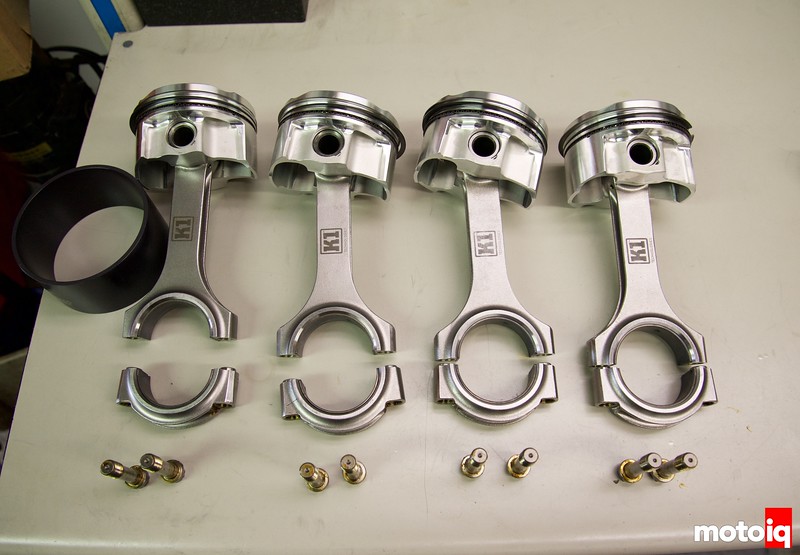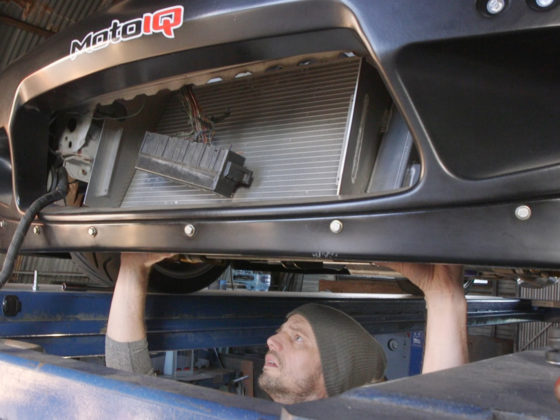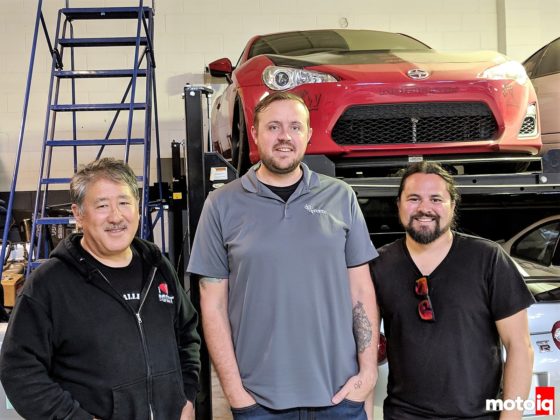 A connecting rod experiences a high amount of compressive and inertial loads, which distorts and ovalizes the connecting rod’s big end bore. This distortion and ovalization causes the connecting rod bolt to undergo bending, tensile, and shear stresses making the connecting rod bolt among the most highly stressed fasteners in an engine. Due to the high levels of stress, K1 connecting rods are equipped with ARP 2000 connecting rod bolts for their high tensile strength and excellent notch toughness. Notch toughness is a material’s ability to resist loads and absorb energy in the presence of a surface imperfection such as a crack or the circumferential, V-shaped notch of a bolt’s threads
A connecting rod experiences a high amount of compressive and inertial loads, which distorts and ovalizes the connecting rod’s big end bore. This distortion and ovalization causes the connecting rod bolt to undergo bending, tensile, and shear stresses making the connecting rod bolt among the most highly stressed fasteners in an engine. Due to the high levels of stress, K1 connecting rods are equipped with ARP 2000 connecting rod bolts for their high tensile strength and excellent notch toughness. Notch toughness is a material’s ability to resist loads and absorb energy in the presence of a surface imperfection such as a crack or the circumferential, V-shaped notch of a bolt’s threads

Since SR20’s are notoriously hard on bearings, particularly rod bearings we used King’s tough XP bearings. The XP bearing is a tri-metal type bearing. It has a steel backing with a lead, copper, tin intermediate layer. The intermediate layer has a high copper content which gives it outstanding load capacity. The intermediate layer is etched using the secure bond process which helps to assure adhesion to the pMax Black overlay. The overlay is fortified with copper nanoparticles which further increase load-bearing capacity while reducing friction and providing improved wear.

The main bearings feature Kings U-Groove technology with 90 degree walls which give more bearing surface area. The oil feed holes are modified versions of Kings ElliptiX oil feed hold design. The grooves are lengthened to help improve the oil feed which helps assure that the rod bearings have enough oil supply. On the 54c SR20’s Nissan uses multiple feed holes and grooved main saddles to do the same thing and these slots can perform a similar function without needing to modify the block. King bearings are very tightly toleranced across the bearing face so the oil clearance is consistent across the crank journal.

The main bearings and the rod bearings, in particular, use King’s RadiaLock dimensioning to get the optimal crush clearance. This helps assure that the bearings will fit perfectly in their bore for good heat transfer and good resistance to spinning. The bearings get clamped tightly in their bores without wear near their parting lines. The bearings also use Kings Eccentrix dimensioning method which takes the oil wedge into account when designing in the bearing material thicknesses. The thickness is varied to help form a more stable and consistent hydrodynamic layer of pressurized oil on the bearings face even at high RPM.




17 comments
Why not OEM main studs?
For competition engines, I prefer not to use them because they are torque to yield and they stretch and take a set. They can only be reused maybe once and it’s a good idea to change them every time on a serious engine.
Mr. Kojima,
How do I get in touch with you on building a Ford V6 motor?
for the mains, did you guys use arp’s torque spec or something else? I always thought it was a bit high
We split the difference. ARP’s torque spec is too high and the threads might pull out.
What does ARP call for and what did you guys end up going with?
ARP states 80 ft/lbs we think that’s too much. We use 65 ft lbs.
No WPC this time?
No not on this engine.
Low Silicone…hehe, I hope those pistons don’t need big boobs.
stupid autocorrect
Are you modifying the upper oil pan to clear the windage tray or did you find/make a spacer? the jet nuts on my tray touch the upper pan and require me to mod my pan.
It’s weird on my FWD engine we did have to mod the pan but on this RWD engine, we didn’t.
Hi!
When would you say the HP limit is for OEM MAIN bolts?
Thanks.
//Daniel
They must be replaced every time but around 500 hp
Thank you. Did you also made an Aline bore after fitting the ARP’s?
Thanks!
We always check and in this case no. For Subarus yes 100% of the time.